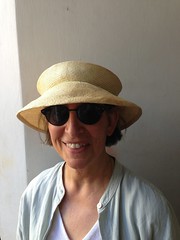
I'm a writer, publishing both as SJ Rozan and, with Carlos Dews, as Sam Cabot. (I'm Sam, he's Cabot.) Here you can find links to my almost-daily blog posts, including the Saturday haiku I've been doing for years. BUT the blog itself has moved to my website. If you go on over there you can subscribe and you'll never miss a post. (Miss a post! A scary thought!) Also, I'll be teaching a writing workshop in Italy this summer -- come join us!
Read/Post Comments (3)
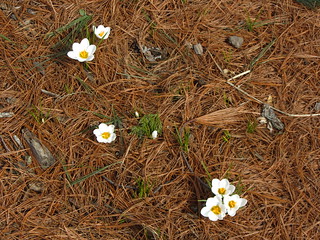
Ulaan Bataar 2
What gradually seeps into the visitor's consciousness in Mongolia is the fuzziness of the line between urban and rural. "Urban" means almost exclusively Ulaan Bataar, where half the population lives, although there are a few other small cities. "Rural" means almost exclusively "nomad," although there are numerous small villages and towns, widely spaced over the steppes and I do mean widely. Nomads in Mongolia are not a small group living a romantic, trading-caravan leftover kind of folk lifestyle. They're herders, and they're pretty much the other half of the population. How many people does that mean? About a million, herding about 20 million head of the "five snouts" of Mongolia: sheep, goats, camels, horses, and yaks. Mixed in with the yaks are cattle, but the two are regarded as the same, and often cross-bred. Mongolia's chief export by far is animal products: meat, wool, cashmere, leather. Mongolia's nomads are at the heart of the economy.
Everyone has relatives in "the countryside," as everything that isn't UB is called. Nomadic doesn't mean you wake up every morning in a different place. Just every season. Families -- sometimes extended, sometimes nuclear -- move their herds either two or four times a year, depending where in the country they live. They move them, and go with them, packing up the ger (=yurt; I'll do a whole post on the ger later) and setting it up in the new pastureland. Mongolia, in essence, is the world's largest unfenced pasture.
So what does this mean for UB, the capital city? It means that this urban place
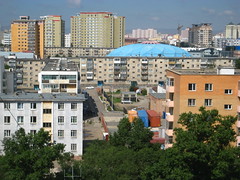
cityscape

cityscape at night
that has the normal urban commerce
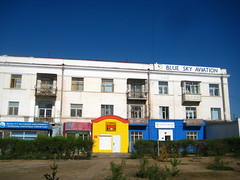
small commercial buildings
and ads
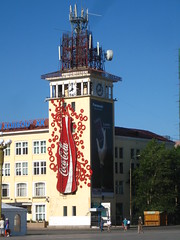
thirsty?
and crowds
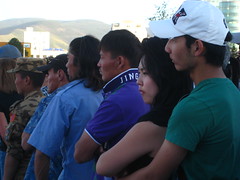
watching the band concert
and sometimes-silly new real estate development
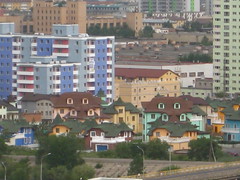
who chose those colors?
and funny food

yum
also gets its meat brought on the hoof right to the edge of town
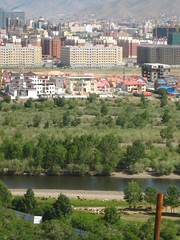
cityscape with goats
and has suburbs unlike anywhere else.
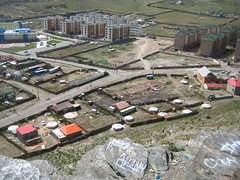
cityscape with gers

ger camp closeup
This is a respectable ger encampment, not a tent-city slum. Many, though not all, of these people will be leaving again when their business in UB is done. The fences are to keep the domestic animals -- horses and dogs -- in. In the countryside, you wouldn't have them, because the gers would be much farther apart and two families' domestic animals wouldn't get involved with each other or get territorial. Neighborhoods like this have either wells or water piping run out to them by the city. Each fenced area has an outhouse/latrine pit. If the families stay too long, that's a problem; in fact sanitation is more and more a problem throughout the country, as towns -- and tourist camps -- grow. What was sustainable over the centuries as normal practice is crashing up against the twenty-first century, in Mongolia as elsewhere. But you see what I mean by the fuzzy line?
Everyone has relatives in "the countryside," as everything that isn't UB is called. Nomadic doesn't mean you wake up every morning in a different place. Just every season. Families -- sometimes extended, sometimes nuclear -- move their herds either two or four times a year, depending where in the country they live. They move them, and go with them, packing up the ger (=yurt; I'll do a whole post on the ger later) and setting it up in the new pastureland. Mongolia, in essence, is the world's largest unfenced pasture.
So what does this mean for UB, the capital city? It means that this urban place

cityscape

cityscape at night
that has the normal urban commerce

small commercial buildings
and ads

thirsty?
and crowds

watching the band concert
and sometimes-silly new real estate development

who chose those colors?
and funny food

yum
also gets its meat brought on the hoof right to the edge of town

cityscape with goats
and has suburbs unlike anywhere else.

cityscape with gers

ger camp closeup
This is a respectable ger encampment, not a tent-city slum. Many, though not all, of these people will be leaving again when their business in UB is done. The fences are to keep the domestic animals -- horses and dogs -- in. In the countryside, you wouldn't have them, because the gers would be much farther apart and two families' domestic animals wouldn't get involved with each other or get territorial. Neighborhoods like this have either wells or water piping run out to them by the city. Each fenced area has an outhouse/latrine pit. If the families stay too long, that's a problem; in fact sanitation is more and more a problem throughout the country, as towns -- and tourist camps -- grow. What was sustainable over the centuries as normal practice is crashing up against the twenty-first century, in Mongolia as elsewhere. But you see what I mean by the fuzzy line?
Read/Post Comments (3)
Previous Entry :: Next Entry
Back to Top